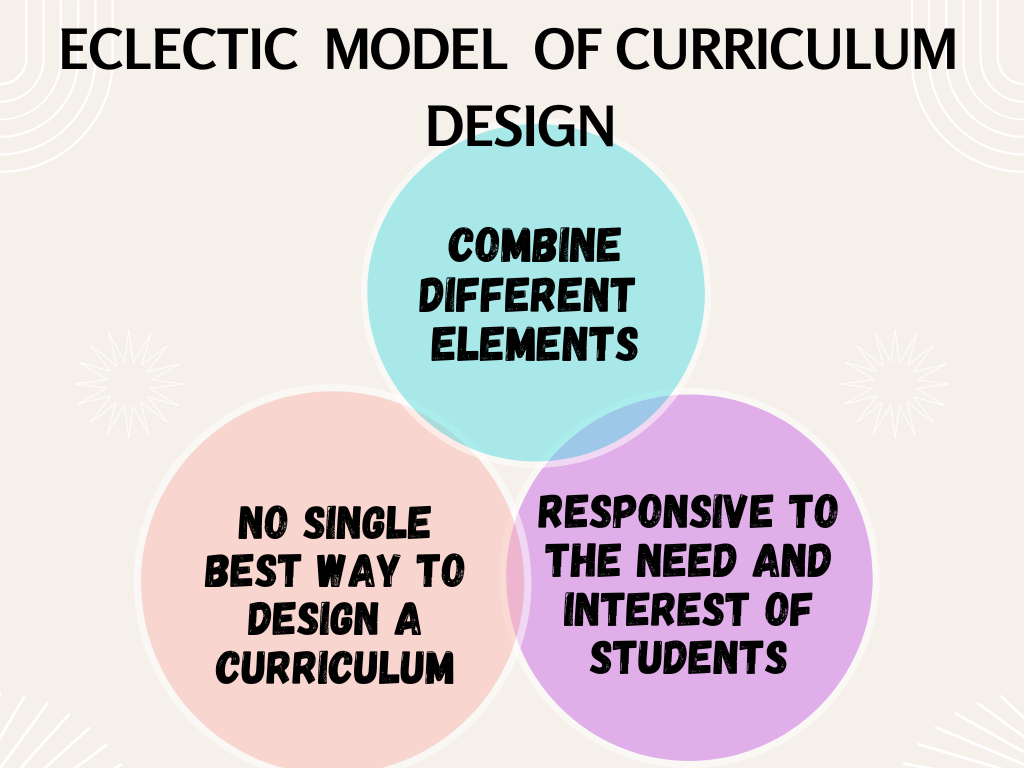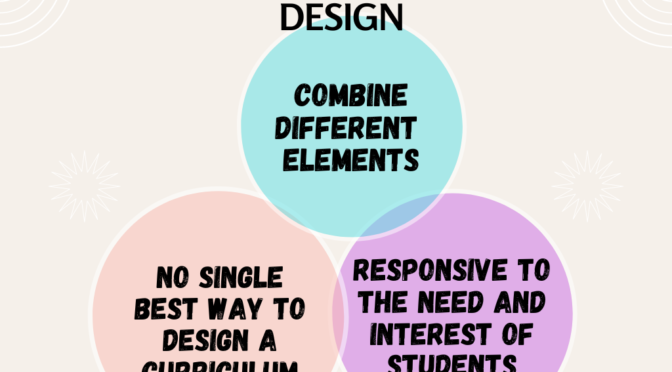The eclectic model of curriculum design is an approach to designing curricula that combines different elements from various curriculum models and theories to create a unique curriculum that meets the needs of a specific group of learners.
This approach recognizes that there is no single “best” way to design a curriculum and that different learners may benefit from different approaches.
Features of Various Models in Eclectic model :
The eclectic model of curriculum design draws on various curriculum models and theories, including Tyler’s objectives model, Taba’s model of curriculum development, the humanistic model, the social reconstructionist model, and the critical theory model. Here is a more detailed explanation of each of these models:
- Tyler’s objectives model: This model emphasizes the importance of defining clear learning objectives and aligning teaching strategies with those objectives. Tyler’s model includes four stages of curriculum design: identifying educational objectives, selecting learning experiences, organizing learning experiences, and evaluating the curriculum.
- Taba’s model of curriculum development: This model emphasizes the importance of involving teachers and learners in the curriculum development process and using a problem-solving approach to curriculum design. Taba’s model includes seven stages: diagnosis of needs, formulation of objectives, selection of content, organization of content, selection of learning experiences, organization of learning experiences, and evaluation.
- The humanistic model: This model emphasizes the importance of focusing on the needs and interests of learners and creating a curriculum that promotes personal growth and development. The humanistic model includes an emphasis on self-directed learning, creativity, and experiential learning.
- The social reconstructionist model: This model emphasizes the importance of using education to promote social justice and address societal issues. The social reconstructionist model includes an emphasis on critical thinking, problem-solving, and action-oriented learning.
- The critical theory model: This model emphasizes the importance of addressing power imbalances and promoting social change through education. The critical theory model includes an emphasis on empowering learners to become agents of social change and promoting critical thinking and reflection.
By combining these different approaches, the eclectic model of curriculum design aims to create a curriculum that is responsive to the needs and interests of learners, promotes personal growth and development, and addresses social and cultural issues. It also recognizes the importance of involving teachers and learners in the curriculum development process and using a flexible approach that can adapt to changing needs and circumstances.



Your point of view caught my eye and was very interesting. Thanks. I have a question for you.
Holgura mecanica
Equipos de equilibrado: importante para el operación uniforme y óptimo de las máquinas.
En el mundo de la tecnología actual, donde la efectividad y la fiabilidad del aparato son de alta trascendencia, los dispositivos de calibración tienen un rol vital. Estos sistemas especializados están diseñados para balancear y estabilizar elementos móviles, ya sea en maquinaria industrial, vehículos de transporte o incluso en dispositivos caseros.
Para los técnicos en soporte de aparatos y los especialistas, operar con equipos de ajuste es importante para garantizar el operación fluido y estable de cualquier sistema rotativo. Gracias a estas soluciones innovadoras avanzadas, es posible reducir significativamente las vibraciones, el zumbido y la carga sobre los sujeciones, prolongando la tiempo de servicio de componentes costosos.
También relevante es el función que tienen los dispositivos de balanceo en la soporte al usuario. El asistencia especializado y el mantenimiento regular utilizando estos dispositivos posibilitan proporcionar soluciones de excelente estándar, aumentando la bienestar de los compradores.
Para los dueños de emprendimientos, la inversión en equipos de equilibrado y sensores puede ser importante para optimizar la eficiencia y productividad de sus aparatos. Esto es principalmente relevante para los inversores que administran pequeñas y intermedias empresas, donde cada detalle vale.
Por otro lado, los sistemas de balanceo tienen una vasta aplicación en el campo de la fiabilidad y el monitoreo de nivel. Facilitan localizar eventuales defectos, impidiendo intervenciones costosas y averías a los aparatos. También, los datos extraídos de estos aparatos pueden utilizarse para mejorar métodos y potenciar la presencia en sistemas de investigación.
Las zonas de uso de los equipos de balanceo abarcan diversas ramas, desde la elaboración de ciclos hasta el supervisión ecológico. No importa si se trata de grandes producciones manufactureras o reducidos locales caseros, los equipos de calibración son esenciales para garantizar un funcionamiento productivo y libre de detenciones.